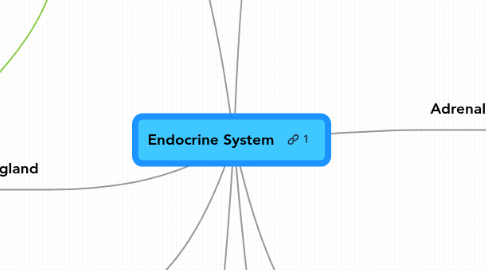
1. Hypothalamus
1.1. Antidiuretic hormone - tells kidneys to reabsorb more water (through posterior pituitary)
1.2. Posterior lobe
1.2.1. Vasopressin hormone
1.2.2. Oxytocin hormone
1.2.2.1. Oxytocin - stimulates contraction of uterine muscles during childbirth, milk ejection//sperm ejection (throught posterior pituitary)
1.3. Anterior Lobe
1.3.1. Follicle-stimulating hormone (FSH) - stimulates secretion of estrogen/speratogenesis
1.3.2. Luteinizing hormone (LH) - stimulates secretion of estrogen and porgesterone/testosterone
1.3.3. Thyroid-stimulating hormone (TSH) - stimulates thyroid to release thyroxine
1.3.4. Growth hormone - stimulates growth, protein synthesis, and fat metabolism
1.3.5. Adrenocorticoptropic hormone (ACTH) - stimulates adrenal cortex to release hormones (glucocorticoids)
1.3.6. Porlactin - stimulates milk synthesis and secretion from mammary glands
2. Pancreas
2.1. Exocrine
2.1.1. secretes important digestive enzymes into duodenum
2.2. Endocrine
2.2.1. islets of langerhans
2.2.1.1. alpha cells
2.2.1.1.1. glucagon
2.2.1.2. beta cells
2.2.1.2.1. insulin
2.2.1.3. delta cells
2.2.1.3.1. somatostatin
3. Testes
3.1. Testosterone - stimulates development of male secondary sexual characteristics and stimulates speratogenesis
3.2. Inhibin - released into the blood when the sperm count is too high, this inhibits the release of GnRH and FSH, which will cause spermatogenesis to slow down.
3.3. Anti- mullerian hormone - regulating sex steroid production in puberty and in the adult ovaries and testes
3.4. Androgens - responsible for the development of secondary sexual characteristics in men, including facial and body hair growth and voice change.
4. Pituitary gland
4.1. Links the nervous and endocrine system through the PITUITARY GLAND
5. Parathyroid (adjacent to thyroid gland)
5.1. Parathormone - stimulates release of calcium from bones
5.1.1. intestines
5.1.1.1. regulates absortion
5.1.2. kindey
5.1.2.1. regulates excretion
5.1.3. bones
5.1.3.1. serves as reservoir (synthesis of Vitamin D
5.2. maintaining a constant concentration to blood
6. Adrenal Gland
6.1. Adrenal Medulla
6.1.1. Epinephrine and Norepinephrine (adrenaline and noradrenaline) - increase levels of sugar and fatty acids in blood
6.2. Adrenal Cortex
6.2.1. Zona Fasciculata (Cortisol)
6.2.1.1. Glucocorticoids - increase blood sugar
6.2.2. Zona Glomerulosa (Aldosterone)
6.2.2.1. Aldosterone - increase reabsorption of salt in kidney
6.2.3. Zona Reticularis (Androgen)
6.2.3.1. Testosterone - causes masculinization of body features
6.2.3.2. Dehydroepindrosterone
7. Thyroid
7.1. Thyroxine (T3) - increases metabolic rate, regulates growth and development
7.2. Triiodothyronine (T3)- inhibits release of calcium from bones
7.3. regulates basic cell metabolism
8. Ovaries (female gonad)
8.1. Estrogen - causes development of female secondary sexual characteristics and maturation of eggs
8.1.1. Estradiol
8.1.2. Estriol
8.1.3. Esterone
